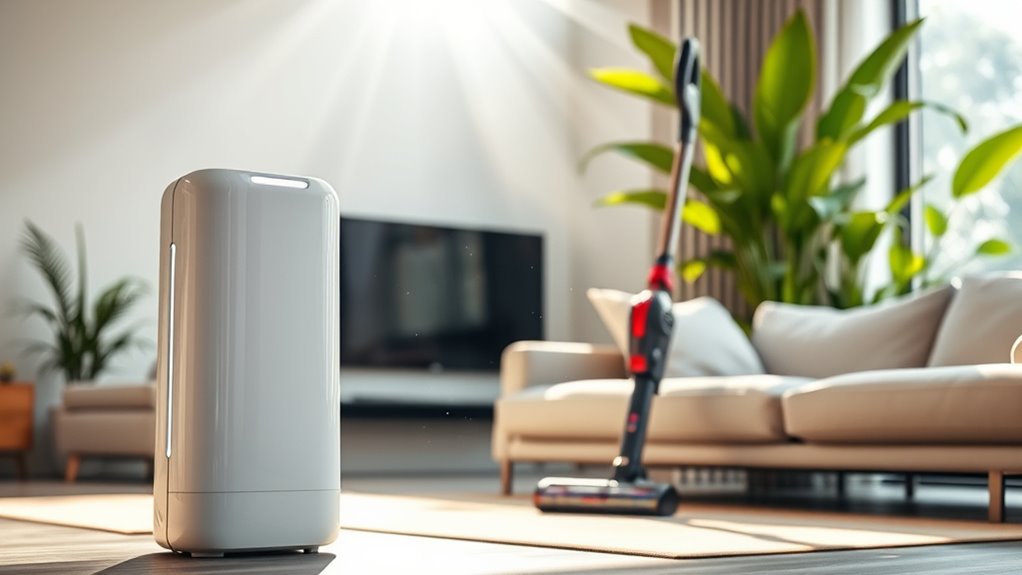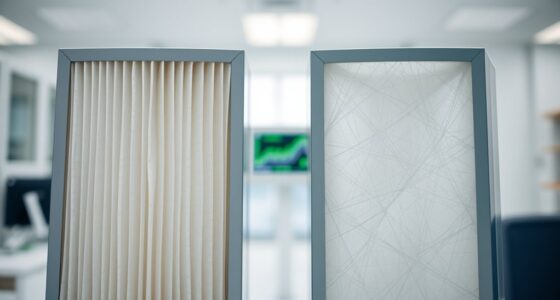Combining air purifiers and vacuums is key to achieving cleaner air in your home. While vacuums remove dust and debris from surfaces, air purifiers continuously filter airborne pollutants, enhancing your indoor air quality. Using a vacuum with a HEPA filter helps trap tiny allergens, and running an air purifier while you clean guarantees any stirred-up particles are captured. This powerful duo not only reduces allergy symptoms but also promotes a healthier living space. Discover more on how to optimize your cleaning routine.
Key Takeaways
- Combining air purifiers and vacuums enhances indoor air quality by targeting both airborne and surface pollutants simultaneously.
- Vacuums with HEPA filters capture fine particles, reducing allergens during cleaning and preventing them from becoming airborne.
- Air purifiers continuously filter out airborne particles stirred up while vacuuming, ensuring cleaner air throughout the home.
- Using both devices regularly leads to fewer allergy symptoms and promotes better sleep by maintaining a healthier environment.
- This integrated cleaning approach ensures thorough removal of allergens, improving overall health and well-being in your living space.

As you navigate the quest for a cleaner home, understanding the roles of air purifiers and vacuums can make all the difference. Both devices serve essential functions in maintaining a healthy indoor environment, especially when it comes to allergen removal. While vacuums tackle dust and dirt from your floors and surfaces, air purifiers work tirelessly to cleanse the air you breathe, and together, they can notably enhance your home’s air quality.
Understanding the roles of air purifiers and vacuums is key to achieving a healthier indoor environment and effective allergen removal.
When you vacuum, you might think you’re done once you’ve picked up visible dirt. However, many allergens—like pet dander, pollen, and dust mites—can still linger in the air. This is where HEPA filters come into play. If your vacuum is equipped with a HEPA filter, you’re already ahead of the game. These filters are designed to trap small particles as tiny as 0.3 microns, making them incredibly effective for allergen removal. When you use a vacuum with a HEPA filter, you’re not just cleaning your floors; you’re also minimizing the amount of allergens that could become airborne again.
Now, let’s talk about air purifiers. These devices are specifically designed to filter out airborne pollutants, including those pesky allergens you might miss with just a vacuum. A good air purifier will have a HEPA filter too, ensuring that it captures a vast majority of allergens in your home. Running an air purifier in conjunction with your vacuuming routine can greatly improve your indoor air quality. While you’re busy vacuuming, your air purifier can be working hard to eliminate any particles stirred up during the cleaning process.
Combining these two devices isn’t just about convenience; it’s about enhancing your overall quality of life. If you suffer from allergies, this duo can provide notable relief. You’ll notice fewer allergy symptoms, better sleep, and an overall healthier home environment. Additionally, using air purifiers can significantly reduce indoor air quality issues, ensuring that the air you and your family breathe is fresh and clean. It’s a simple yet effective strategy to ensure you’re not just cleaning your floors but also ensuring the air you and your family breathe is fresh and clean.
Frequently Asked Questions
How Often Should I Replace Air Purifier Filters?
You should replace your air purifier filters every 6 to 12 months, depending on the filter lifespan and usage. If you notice reduced airflow or a musty smell, it’s time to change the filter, even if it’s not been a year. Keep an eye on the manufacturer’s recommendations for replacement frequency, as this varies by model. Regularly checking your filters helps maintain ideal air quality and improves the purifier’s efficiency.
Can Vacuums Remove Allergens From the Air?
Yes, vacuums with HEPA filtration can effectively remove allergens from the air. When you use a vacuum equipped with a HEPA filter, it traps tiny particles like dust mites, pet dander, and pollen, improving your home’s air quality. Make sure you vacuum regularly, especially in high-traffic areas, to keep those allergens at bay. By doing this, you create a healthier environment for you and your family.
Are Air Purifiers Noisy During Operation?
Air purifiers don’t have to be noisy! Many models are designed with noise levels in mind, offering whisper-quiet operation even on high settings. Imagine breathing easier without the distraction of loud machines humming in the background. With advancements in technology, you can find air purifiers that focus on noise reduction without sacrificing performance. So, you can enjoy cleaner air and peace of mind simultaneously—what more could you ask for?
Do I Need Both a Vacuum and an Air Purifier?
Yes, you need both a vacuum and an air purifier for maximum cleanliness. A vacuum handles dirt, dust, and allergens from your floors, while an air purifier tackles airborne particles. Make sure you stay on top of vacuum maintenance to keep it effective. For the air purifier, choose the right placement in your home to maximize its efficiency. Together, they create a healthier living environment by targeting different sources of pollutants.
What Room Size Is Ideal for Air Purifiers?
The ideal room size for air purifiers usually depends on the purifier’s capacity. Most purifiers are rated for specific square footage, so you’ll want to check the specifications. For small rooms, like bedrooms, a purifier with a capacity of 200-400 square feet works great. In larger spaces, like living rooms, you might need a unit rated for 500 square feet or more. Always choose a purifier that matches your room size for superior performance!
Conclusion
By combining air purifiers and vacuums, you’re not just cleaning your home; you’re transforming it into a sanctuary. You might think it’s too much work, but imagine the fresh, crisp air you’ll breathe in after a thorough vacuuming and purification session. Picture your family enjoying time together without the worry of allergens or dust. With these two powerful allies, you can create a healthier, more inviting space for everyone to thrive. Embrace the change!









